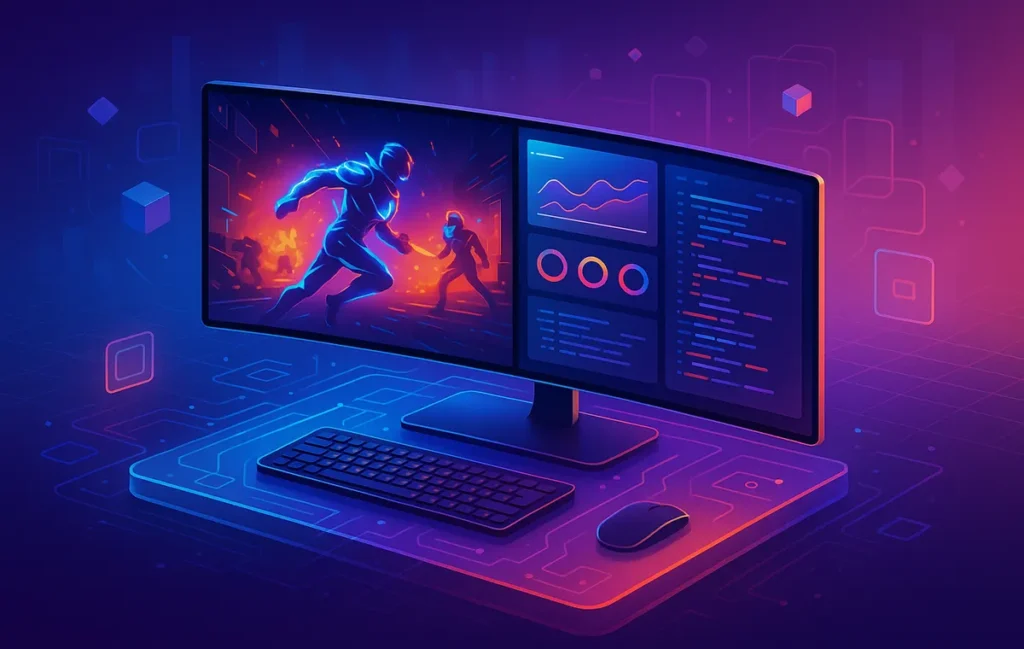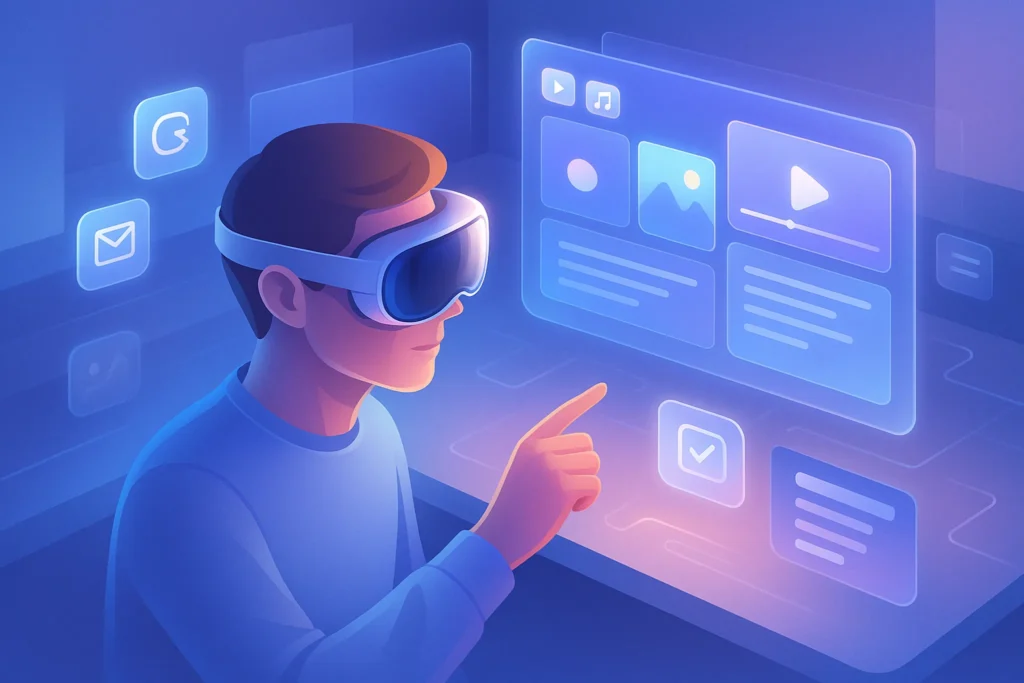🌍 Why OLED Monitors Dominate 2025
OLED monitors have shifted from luxury to mainstream in 2025. Once reserved for high-end enthusiasts, these panels are now standard in gaming setups, creative studios, and even home offices. The reason? Unmatched contrast, near-instant response times, and vibrant color reproduction that IPS and VA panels simply cannot match.
For gamers, OLED delivers the competitive edge—every frame is sharper, every shadow is deeper, and every reaction is faster. For productivity, OLED makes long editing sessions more comfortable and documents clearer, thanks to pixel-perfect sharpness. Compared to setups covered in Best Budget Monitors for Work From Home or guides like Portable Monitors and Other Underrated Productivity Gear, OLED is less about compromise and more about investing in the ultimate visual experience.
💡 Nerd Tip: Once you move to OLED, going back to traditional LCD feels like stepping from a sports car into a bus.
🎮 OLED for Gaming: Performance First
Gamers demanded more than 144Hz refresh rates—and OLED answered. Today’s OLED monitors, from 27-inch to ultra-wide 45-inch beasts, run at 240Hz with near-zero input lag. HDR performance is another level: deep blacks make horror games terrifying, and wide color gamuts make open-world landscapes feel alive.
One user on X summed it up perfectly:
“I switched from a high-end IPS to a 34” OLED. Same GPU, same settings—yet the immersion felt like a generational leap. Blacks weren’t gray anymore. Shadows felt real.”
Beyond immersion, OLED is about responsiveness. Tests show that 240Hz OLED panels reduce input lag by up to 25% compared to premium IPS. For competitive esports players, that’s not just luxury—it’s measurable advantage.
💡 Nerd Tip: Pair OLED monitors with VRR (G-Sync or FreeSync) for buttery smooth gameplay without tearing.
💼 OLED for Productivity: Clarity & Comfort
While OLED often gets hyped for gaming, productivity benefits are just as transformative. Writers, coders, and video editors who spend 8+ hours at a desk report reduced eye strain, thanks to OLED’s perfect pixel illumination. Text is razor-sharp, and color-critical tasks—like video editing or digital art—become far more reliable.
Designers moving from standard LCDs see color accuracy improve dramatically, with coverage often hitting 99% DCI-P3 and 100% sRGB. This makes OLED indispensable for professional creatives. Paired with a dual setup like in How to Set Up a Dual-Monitor Gaming Station, OLED can handle both primary creative work and entertainment seamlessly.
💡 Nerd Tip: For productivity-heavy use, enable automatic dimming features—this helps mitigate burn-in risks over years of usage.
📊 Comparing Top OLED Monitors in 2025
| Monitor | Best For | Key Strengths | Limitation |
|---|---|---|---|
| LG UltraGear 32GS95UE | Competitive gaming | 240Hz refresh, low latency, HDR1000 | Price premium |
| Alienware AW3425DW | Immersive ultra-wide | 34” curved OLED, G-Sync Ultimate | Requires strong GPU |
| Asus ProArt OLED PA32DC | Creative professionals | Industry-grade color accuracy | Limited refresh rate |
| Samsung Odyssey OLED G9 | Productivity + gaming | 49” super ultra-wide, multitasking beast | Desk space, high cost |
| Corsair Xeneon Flex 45WQHD240 | Flexibility | Bendable flat-to-curve OLED panel | Early-gen durability concerns |
💡 Nerd Tip: Ultra-wide OLEDs double as work + play setups—your workflow and games both win.
🔄 Productivity Meets Portability
The OLED trend isn’t only about desktops. Portable OLED monitors are gaining traction as lightweight companions for laptops and handhelds like the Steam Deck OLED Review. These screens give remote workers and digital nomads the same deep blacks and sharp visuals on the go.
For example, 16-inch OLED travel monitors now weigh under 1kg and deliver color accuracy comparable to studio monitors. Combined with guides like How to Use Multiple Monitors Like a Pro, you can build a mobile workstation that rivals desktop setups.
💡 Nerd Tip: Portable OLEDs are perfect for presentations—vivid visuals stand out in client meetings far more than standard LCDs.
⚡ Ready to Experience OLED Brilliance?
Upgrade to OLED monitors for unmatched gaming speed and productivity clarity. Explore models from LG, Alienware, and Samsung to find your perfect fit.
🚧 Burn-In & Longevity Concerns
No OLED review is complete without mentioning burn-in. While manufacturers have improved pixel-shifting and dimming technologies, heavy static usage—like spreadsheets or UI-heavy games—can still pose long-term risks.
Real-world tests show that with normal mixed usage, modern OLEDs last over 30,000 hours without noticeable burn-in. That’s nearly a decade of daily 8-hour use. Still, for pure productivity users, LCD remains safer for static-heavy environments.
💡 Nerd Tip: Mix gaming, browsing, and productivity to maximize OLED life. Avoid leaving static images overnight.
🔮 The Future of OLED Monitors Beyond 2025
Looking forward, OLED monitors are evolving into QD-OLED hybrids with higher brightness and longer life. Early QD-OLED panels in 2025 already deliver 20–30% brighter HDR while reducing burn-in risks.
By 2027, expect mainstream adoption of rollable OLED monitors and even higher refresh rates beyond 360Hz for esports dominance. For productivity, AI-enhanced OLED monitors may auto-adjust brightness and contrast based on workload type—editing, reading, or gaming.
💡 Nerd Tip: If you’re buying today, QD-OLED gives you the longest future-proof runway without waiting for rollables.
⚖️ Pros & Cons per Monitor Model
Every OLED monitor has strengths and trade-offs that show up in daily use.
LG UltraGear 32GS95UE is a 32-inch, 240Hz panel designed for competitive gamers. Its main advantage is ultra-low latency and true HDR1000. The drawback is the premium price—perfect for those who demand top-tier performance but hard to justify for casual users.
Alienware AW3425DW delivers incredible immersion with its 34-inch curved OLED. Fast refresh rates and G-Sync Ultimate make it a dream for gamers. But it demands a powerful GPU to run at its full potential and consumes more power than smaller panels.
Asus ProArt OLED PA32DC is purpose-built for creatives. Its color accuracy and full-spectrum coverage make it indispensable for editors and designers. The limitation is its lower refresh rate, which makes it less suited for competitive gaming.
Samsung Odyssey OLED G9 is a 49-inch super ultrawide that doubles as both a productivity hub and a gaming beast. It lets you run multiple apps side by side or immerse yourself in massive open worlds. The trade-offs are desk space and a hefty price tag.
Corsair Xeneon Flex 45WQHD240 is innovation at work: a bendable OLED that shifts between flat and curved. It’s perfect for users who want flexibility. But as a first-generation design, durability of the bending mechanism remains a long-term question.
💡 Nerd Tip: Think of OLED monitors like cars—each model is built for a specific lifestyle.
🧩 Integration with Gaming & Productivity Setups
An OLED monitor is more than a display—it’s the centerpiece of your setup.
Competitive players often choose the LG 32GS95UE in a single-monitor configuration because refresh rate and latency matter most. Meanwhile, the Odyssey G9 fits professionals who multitask while gaming; its massive 49-inch ultrawide can replace dual setups, letting you video edit and game seamlessly on one screen.
Content creators tend to add the Asus ProArt OLED to dual-monitor workstations: one color-accurate display for editing and a secondary monitor (or even a Portable Monitor) for chat, scripts, or multitasking.
Flex users—the ones who want versatility—gravitate toward the Corsair Xeneon Flex, enjoying a flat display for office hours and a curved one for late-night RPGs or racing sims.
💡 Nerd Tip: Combine OLEDs with strategies from How to Use Multiple Monitors Like a Pro or How to Set Up a Dual-Monitor Gaming Station to unlock full workflow power.
💵 Cost vs Value Analysis
OLED monitors in 2025 aren’t cheap, but their value depends on the type of user.
Competitive gamers view the LG UltraGear or Corsair Flex as investments. Every millisecond saved and every frame rendered smoother can mean real-world wins. For them, performance is worth the premium.
Creative professionals often find the Asus ProArt OLED worth every dollar. Its color accuracy ensures better projects, happier clients, and higher payouts—ROI is measured in quality.
Hybrid users, those balancing work and play, get the most value from Alienware or Samsung ultrawides. Instead of buying two separate monitors, one OLED ultrawide covers gaming immersion and productivity multitasking.
💡 Nerd Tip: Value isn’t just cost—it’s the return in performance, efficiency, or creative output.
🚧 Failure Scenarios & User Complaints
Even the best OLEDs come with real-world complaints.
Burn-in remains the number one worry. A user on X wrote:
“After 10 months of heavy spreadsheet use, app logos faintly stuck. Games looked fine, but static UIs left marks.”
Fan noise is another concern. Some Alienware OLED models use active cooling, and owners report hearing fans under heavy loads. Corsair Flex raised eyebrows at launch with questions around the bending mechanism’s long-term reliability.
Brightness also divides opinion. In bright, sunlit offices, OLEDs sometimes appear dimmer compared to high-end LCDs, though newer QD-OLED tech is closing that gap.
💡 Nerd Tip: Always check long-term reviews and user forums—real issues surface from communities, not marketing brochures.
🔮 Future-Proofing & Tech Roadmap
The OLED roadmap beyond 2025 is brighter—literally. QD-OLED panels already deliver 20–30% higher peak brightness and improved lifespan, cutting burn-in risks significantly.
By 2027, expect OLED monitors with refresh rates beyond 360Hz aimed squarely at esports dominance. Rollable OLED monitors are in prototype stages, promising transportable large-format displays.
AI integration is another frontier: imagine monitors that automatically adjust brightness, contrast, and even color profiles based on whether you’re coding, editing, or gaming. Early experiments hint this could be a reality within the next two years.
💡 Nerd Tip: If you’re buying today, QD-OLED offers the safest, most future-proof path—better HDR, stronger brightness, and durability baked in.
📬 Want OLED Insights & Gear Reviews?
Join NerdChips for weekly deep dives on gaming monitors, productivity setups, and the latest display tech shaping work and play.
🔐 100% privacy. Just value-packed reviews and insights.
🧠 Nerd Verdict
OLED monitors in 2025 are no longer niche—they’re the new gold standard. For gamers, OLED delivers competitive speed and lifelike immersion. For professionals, it elevates productivity with unmatched clarity and accuracy. The NerdChips verdict: if you’re investing in your setup this year, OLED is no longer optional—it’s the baseline.
❓ FAQ: Nerds Ask, We Answer
💬 Would You Bite?
If you had to choose, would you go for an ultra-wide OLED for immersion or a 27–32” panel for sharp, focused productivity?
Crafted by NerdChips for creators and gamers who demand the best screens for work and play.



